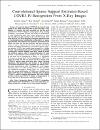Performance Comparison of Learned vs. Engineered Features for Polarimetric SAR Terrain Classification
Abstract
In this work, we propose to use learned features for terrain classification of Polarimetric Synthetic Aperture Radar (PolSAR) images. In the proposed classification framework, the learned features are extracted from sliding window regions using Convolutional Neural Networks (CNNs), and then they are used for the classification with the linear Support Vector Machine (SVM) classifier. The classification performance of the proposed approach is compared with numerous target decomposition theorems (TDs) as the engineered features tested with two classifiers: Collective Network of Binary Classifiers (CNBCs) and SVMs. The experimental evaluations over two commonly used benchmark AIRSAR PolSAR images, San Francisco Bay and Flevoland at L- Band, reveal that the classification performance of the learned features with CNNs outperforms the performance of the engineered features as TDs even the dimension of learned features is the quarter of the engineered features.
DOI/handle
http://dx.doi.org/10.1109/PIERS-Spring46901.2019.9017716http://hdl.handle.net/10576/30620
Collections
- Electrical Engineering [2857 items ]
Related items
Showing items related by title, author, creator and subject.
-
Multifrequency Polsar Image Classification Using Dual-Band 1D Convolutional Neural Networks
Ahishali M.; Kiranyaz, Mustafa Serkan; Ince T.; Gabbouj M. ( Institute of Electrical and Electronics Engineers Inc. , 2020 , Conference)In this work, we propose a novel classification approach based on dual-band one-dimensional Convolutional Neural Networks (1D-CNNs) for classification of multifrequency polarimetric SAR (PolSAR) data. The proposed approach ... -
How divided is a cell? Eigenphase nuclei for classification of mitotic phase in cancer histology images
Awan, Ruqayya; Aloraidi, Nada; Qidwai, Uvais; Rajpoot, Nasir ( Institute of Electrical and Electronics Engineers Inc. , 2016 , Conference)Detection of mitotic cells in histology images is an important but challenging process due to the resemblance of mitotic cells with other non-mitotic cells and also due to the different appearance of mitotic cells undergoing ... -
Convolutional Sparse Support Estimator-Based COVID-19 Recognition from X-Ray Images
Yamac M.; Ahishali M.; Degerli A.; Kiranyaz, Mustafa Serkan; Chowdhury M.E.H.; Gabbouj M.... more authors ... less authors ( Institute of Electrical and Electronics Engineers Inc. , 2021 , Article)Coronavirus disease (COVID-19) has been the main agenda of the whole world ever since it came into sight. X-ray imaging is a common and easily accessible tool that has great potential for COVID-19 diagnosis and prognosis. ...


